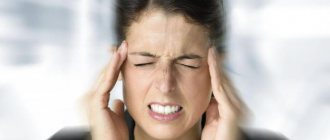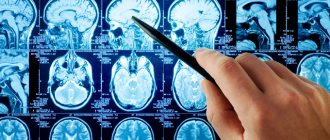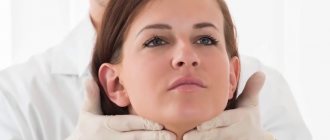Withdrawal syndrome in alcoholism: how withdrawal syndrome is treated (relief) after alcohol, sleeping pills for sleep, how long abstinence lasts, drugs for treatment
Withdrawal syndrome or withdrawal is a state of physical need for a new dose of alcohol.
It is accompanied by a wide clinical picture and is extremely painful for patients. Develops starting from the third stage of alcohol dependence.
In some cases, the first signs of the disorder are noticeable in the second stage of the pathological process.
If nothing is done, a person will most likely not be able to stand it, will break down and start drinking in order to somehow alleviate the condition. This is precisely what makes the situation insidious. To normalize the condition, drug treatment is needed.
Clinic "Help Is Here"
We treat addiction in all its forms. In particular, we carry out detoxification to remove the remnants of alcohol and its metabolites from the body.
We eliminate irrepressible cravings for alcohol, correct alcohol withdrawal syndrome at home and in the hospital.
You can get more information about the duration, signs of withdrawal syndrome, and methods of assistance by calling.
What is withdrawal syndrome
This is the post-drinking period. The functioning of the human body is disrupted, problems appear with:
psychomotor reactions (difficulty walking, standing, doing physical exercises);
digestive tract (from heartburn to intestinal colic);
cardiovascular system (due to spasms, headaches, increased heart rate, high blood pressure);
design and expression of thoughts (the person will not say the name and city of stay, will not give the date, or will think about the question for a long time).
Alcohol withdrawal syndrome is commonly called withdrawal syndrome abroad. When the body comes to its senses because the administration of ethyl alcohol has been discontinued, adverse reactions occur. The reason for this is the desire of the organs to quickly recover and throw the poison out so that it does not destroy cells or interfere with their functions. Therefore, profuse vomiting, diarrhea, and a feeling of drowsiness occur. With AS, these changes are stopped by breastfeeding. Popularly called “withdrawal”, it manifests itself in the same way in alcohol and drug addicts.
Each stage of alcoholism will have a different feeling of heaviness. There are six of them:
Mild stage – headache, dry mouth, drowsiness. It takes place in the first half of the day and does not require auxiliary activities.
Moderate – previous symptoms intensify, increased heart rate, severe dizziness, nausea and vomiting, and sometimes other gastrointestinal disorders are added. Within 24 hours the patient requires a hangover.
Severe – an addict with this disorder experiences mood swings, which is accompanied by an aggressive reaction to refusing a new dose. Signs of intoxication intensify, plus tremors, insomnia, and body pain begin. The patient uses again to “get better,” otherwise the feeling of poor health lasts a day or more.
Acute AS – the disease progresses and nightmares, sleep problems, paranoid thoughts, and depression are added. There is no expectation of improvement in the next week; my serious condition forces me to drink more and more.
Expanded AC - will mark the transition from stage 2 to stage 3. Thoughts of persecution, feelings of shame or anger, anxiety that does not subside, sleep is impossible, seizures. Full-blown AS lasts for up to a week, and nervous tension increases.
AS with psychoorganic disorders - previously caused symptoms intensify, alcohol is not excreted, since the person drinks hopelessly. He is unable to formulate simple sentences, answer questions, reactions and behavior are unpredictable, which indicates brain damage. Hallucinations appear.
If there is a constant craving for alcohol, when the body and brain cannot live without it, a preliminary diagnosis is already made. If relatives see that a loved one regularly goes on binges with a simultaneous loss of interest in life, then these are the first signs of alcoholism. It is necessary to seek help.
Symptoms by severity
Withdrawal syndrome has similar symptoms to a hangover and alcohol poisoning. The difference with the latter state is in the time of manifestation: not at the moment of intoxication, but several hours after sobering up.
The difference between withdrawal and hangover syndrome is the increasing intensity of symptoms and the presence of mental disorders (depression, hysteria, psychosis, hallucinations). A hangover is characterized only by vegetative-asthenic and vegetative-somatic abnormalities.
There is a classification of withdrawal according to severity: it is divided into mild, moderate, severe. Doctors use the CIVA-Ar Alcohol Withdrawal Syndrome Assessment scale to determine the form of the pathology. You can determine the degree of withdrawal syndrome in alcoholism yourself by the external symptoms observed in the patient.
| Characteristic | Alcohol withdrawal form | ||
| Lightweight | Moderate | Heavy | |
| Vegetative-asthenic symptoms | Thirst, sweating, temperature up to 37.5° | Tachycardia, mild itching, photophobia | Tactile hallucinations, temperature above 38° |
| Vegetative-somatic symptoms | Mild headache, nausea, loss of appetite | Fever, vomiting, tremors, severe headache | Convulsive seizures, respiratory rate above 24 per minute |
| Mental symptoms of the syndrome | Insomnia, increased anxiety | Hysteria, neuroses, depression | Adjunct to withdrawal delirium with hallucinations. |
At home, without the involvement of doctors, you can treat the first form of withdrawal. Moderate withdrawal syndrome in alcoholism is eliminated on an outpatient basis (that is, diagnosis and treatment are carried out by a doctor at home or during periodic visits by the patient to the clinic). The severe stage requires hospitalization of the alcoholic.
What is a hangover
Many people drink on holiday or just when meeting, but not everyone suffers in the morning. This depends on individual sensitivity to ethyl and the amount drunk. A hangover is intoxication that appears 4-12 hours after sleep. With alcohol poisoning (which is what a person feels in the morning) the following occurs:
- dizziness;
- moderate headache;
- thirst;
- reduced attention;
- weakness;
- nausea;
- increased blood pressure;
- mild or complete apathy.
With a large dose of alcohol, it is difficult for the liver to process, neutralize and remove breakdown products in a short period. To help itself, the body blocks some of the nerve receptors and creates impulses that cause aversion to alcohol-containing products. The hangover goes away in the afternoon, although its effects are only slightly felt until the evening.
There is no suppression of cognitive functions, a decrease in the speed of mental processes, and it is easy to control a person’s reaction. Drinking alcohol is impossible; just the thought makes you sick. The occurrence of such symptoms indicates that the body is struggling and wants to remove toxins. The higher the blood alcohol content, the longer it will take to relieve symptoms.
In a healthy person, such a reaction is positive; the disease has not yet developed. But due to the influence of ethanol, the condition is poor. A hangover is not dangerous and often goes away on its own. The maximum you need is drinking water, rest, sleep, light food. One day and a person is like a cucumber.
And remember about allergic reactions. They manifest themselves in the form of severe nausea, rash, loss of consciousness, and suffocation. They occur almost immediately after drinking, before intoxication sets in. This situation is dangerous and requires medical intervention. Only they can relieve the victim of allergies with the help of medications. You won't be able to do anything on your own.
What is the difference between a hangover and withdrawal symptoms?
Uninformed people often confuse these terms. The signs are similar, but a clear distinction is needed to establish diagnosis and treatment. And it’s easy to describe - if in the morning, at the sight or thought of alcohol, a steady urge appears as the body’s response, then this is good. A promise to yourself not to drink anymore, or to drink in smaller quantities, a desire not to repeat mistakes is a hangover. If in this position you give even a shot glass to drink, it will immediately come back out.
With abstinence, the general picture is the opposite - without alcohol it only gets worse, and a hangover allows you to relieve pain. It has the effect of a drug. That is, the patient is so accustomed to receiving intoxicating drinks that without it he feels a lack of an important element. His absence is painful. Chronic alcoholism almost immediately leads to the development of abstinence. It is difficult to get rid of addiction at this stage without outside help.
Drinking alcoholic beverages is addictive, they are sold everywhere, drinking is easy and tasty, and the feeling of euphoria is pleasing. But it’s important to stop in time, if after a party you want five more drops, then it’s time to get treatment.
Pathogenesis of alcohol withdrawal
The development of dependence on the use of alcoholic beverages is associated with their ability to change the natural functioning of the nervous tissue. After the product enters the body, fermentation occurs, which is accompanied by the formation of specific metabolites. Acetaldehyde, formed as a result of the breakdown of alcohol, can influence the breakdown and synthesis of the neurotransmitter dopamine. This substance takes an active part in the process of transmitting nerve impulses. Ethanol itself binds to receptors in the brain. This reaction allows you to compensate for the lack of dopamine. Therefore, with abstinence and complete refusal of alcohol-containing drinks against the background of their long-term use, alcohol withdrawal syndrome occurs. The patient experiences withdrawal, that is, an uncontrollable desire to consume ethanol. In addition to psychological stress, the body also faces exhaustion of the nervous system, as well as a violation of the detoxification function of the liver, which undergoes pathological changes. This condition is called alcohol withdrawal syndrome. The difficulty in treatment lies in the simultaneous failure of many organs. That is why it is often impossible to cope with the disease at home. When the first signs of a problem occur, you should seek medical help.
Why is treatment for withdrawal symptoms necessary?
Medical articles explain in scientific terms the reasons for the rapid treatment of withdrawal symptoms. But for ordinary people, “delirium tremens” seems to be a phenomenon that is present while you drink and goes away when you sober up. But in reality everything is much more complicated. Everyone tells an alcoholic: “Get out of the binge, quit, don’t be a wuss, think about yourself and your loved ones, how you look.” But it's not that easy. Binge drinking can last for days and weeks, months and years. With constant drinking, the production of hormones is disrupted. Then, the lack of ethanol levels in the blood, even for a couple of hours, leads to internal stress. Now the person is dependent on alcohol, the dosage is increasing, but the morning is getting harder and harder. Lack of treatment threatens not only malfunctions of internal organs, but also changes in the psyche.
All organs suffer from drinking, and a lot of diseases appear - cirrhosis, pancreatitis, gastric ulcers, colitis, gastritis. The risk of stroke, heart attack, and vein thrombosis increases. After heavy drinking, men and women often suffer from infertility, and girls may experience abnormal development of the child, difficulties and poor health during pregnancy. This bouquet does not appear immediately, but the disorders become irreversible and remain even after treatment. Therefore, the basis of full-fledged therapy is an early visit to a doctor. It is difficult to overcome addiction and recover at home. In the hospital, treatment is supervised by doctors - narcologists, psychiatrists, and therapists. This makes the therapy safer.
There are other dangers of withdrawal:
In addition to the underlying disease, decreased immunity and increased susceptibility to viruses and bacteria are added. Alcoholics belong to risk groups for tuberculosis and hepatitis.
In the active form of alcoholism, the patient commits rash acts - he hits himself, gets injured, hurts himself. He has a lower pain threshold, and therefore a higher risk of suffering from injury.
Alcohol forces you to have sexual intercourse, and contraception is not always available. There is a higher risk of contracting a sexually transmitted infection (gonorrhea, syphilis, HIV).
Medical care is required for people suffering from withdrawal symptoms. Treatment under the supervision of professionals allows you to eliminate a bad habit and return to a joyful life without stimulants.
How to relieve the syndrome at home
The main condition for treatment at home is not to let the patient drink alcohol. The fact is that an alcoholic knows that if he drinks vodka, the withdrawal symptoms will go away and his condition will quickly improve. But drinking alcohol will lead to a new binge, increase the risk of intoxication, and subsequent abstinence will become much more severe than the previous one.
You can relieve withdrawal symptoms at home with folk remedies and over-the-counter medications (to help the patient fall asleep, relieve pain, and normalize the functioning of internal organs). A diet aimed at removing toxins and strengthening the body is mandatory. If you cannot cure an alcoholic at home (20–30 hours pass, and the symptoms of the syndrome increase), you need to call a doctor.
Medicines to help
The goals of taking pharmaceutical drugs during withdrawal symptoms are to relieve the threat of complications, relieve symptoms, and detoxify. It is better to start treatment with Activated Carbon (daily dose – 1 tablet per 10 kg of alcoholic’s weight, minimum course – 3 days).
Note: The most effective cure for binge drinking.
Drinking water with added table salt will help enhance the absorption effect of the medicine. Such a “cocktail” will restore the electrolyte balance in the body and reduce intoxication. The choice of other means depends on the signs of withdrawal that bother alcoholics:
- To eliminate anxiety, insomnia: Valerian, Phenibut.
- To improve metabolism: Actovegin, Piracetam.
- To normalize the functioning of the pancreas and liver: Milk thistle, Hepabene.
Alcohol withdrawal syndrome increases with a deficiency of micro- and macroelements. Vitamin therapy will help the patient get rid of withdrawal symptoms faster, reduce the threat of complications, and strengthen the immune system. Be sure to take medications with thiamine (vitamin B1) and ascorbic acid. Products with glucose, fructose, and riboflavin are also indicated.
ethnoscience
During the abstinence period, it is important to prevent the alcoholic from getting drunk again. A folk remedy such as a decoction of oats with St. John's wort will help eliminate cravings for alcohol: pour 400 grams of grains and a handful of dried flowers into a liter of water, put on fire and boil for half an hour. Take half a glass daily before meals.
Also on the topic: How to quit binge drinking at home: advice from a narcologist.
A herbal mixture of mint, linden blossom and elderberry (brew and drink 2-3 times a day) helps to cope with nausea, vomiting, weakness, and tremors. To cleanse the body and stimulate the urinary system, a mixture of raspberry leaves, lemon, and honey is suitable. It is recommended to treat the nerves of an alcoholic during the abstinence period with herbal tea with cornflower flowers, thyme, and chamomile.
Other home remedies
A patient with withdrawal symptoms has poor appetite due to constant nausea and impaired metabolism. During the period of treatment of an alcoholic at home, you cannot force him to eat regular food, as this will provoke vomiting. But fasting is also prohibited; the patient’s body needs energy to recover. A special diet can help, which should include chicken broth, vegetable puree soups, fruits and vegetables, kefir, and cottage cheese.
A special requirement is placed on the drinking regime. During withdrawal symptoms, you need to drink a lot of fluids (to facilitate and speed up detoxification). An adult man will have to drink at least 1.5 liters of water (plain or infused with lemon, honey, ginger). Additionally, berry fruit drinks and juices are recommended (carrot, beet, and birch juices are especially useful) - they help fight dehydration and give the alcoholic the necessary vitamins.
How to relieve alcohol withdrawal syndrome
Frequent, continuous consumption of strong drinks does not go away without leaving a trace. Alcoholics belong to the group of patients who are difficult to treat, and therefore it is recommended not to take steps on their own, but to enroll in a specialized medical institution. The difficulty is that treatment cannot be started without the patient’s knowledge; he must express his desire. The use of coercion is permissible only if the patient poses a threat to himself or others. Treatment for alcoholism is carried out when something wrong is noticed not only by relatives, but also by the sufferer himself.
Relief of alcohol dependence withdrawal syndrome consists of several parts:
- Removing poison.
- Relieving therapy.
- Psychotherapeutic sessions.
- Rehabilitation course.
The therapy is supervised by a narcologist. He prescribes medications to the patient, chooses a course, and sets deadlines. Drug treatment requires a balanced approach, since the active ingredient of the drug is selected for each person. A lot of products with indications and contraindications are produced on the pharmaceutical market. Prescribing pills is a purely medical matter. When stopping, the dose is controlled, since side effects of one or another component are not uncommon.
The method used in the clinic includes:
Restoring water-salt metabolism, first with droppers (saline and glucose), then drinking plenty of fluids, including mineral waters. The volume of liquid gradually increases, reaching 2 liters per day.
Vitamin C and B vitamins are introduced. They stimulate the immune system and restore damaged organs.
Benzodiazepine tranquilizers (diazepam, lorazepam) give the body false information that ethanol has again entered the blood. They have a similar effect, but due to medical supervision they do not cause harm. Used to ease withdrawal symptoms, the dose is slowly reduced.
In case of increased excitability, sedatives, stabilizers, and sleeping pills are given.
Antidepressants are prescribed for severe signs of apathy, indifference, depression, unwillingness to recover, and depression.
In case of disturbances in the gastrointestinal tract, sorbents (Enterosgel, activated carbon) are used.
Diuretic, cardiovascular, and anticonvulsant drugs are given only when necessary.
If the patient does not respond to therapy, then the clinic performs plasmapheresis - blood components are infused. This cleansing works in a couple of hours.
As soon as withdrawal symptoms are controlled by these medications, the rehabilitation course begins. A psychologist or psychiatrist works with the patient. Maintenance drug therapy – only when indicated. When leaving the hospital, a person will not only feel good physically, but will also understand that life is better without going to bars.
Author of the article: Yakovlev Evgeniy Anatolyevich
Narcologist, Candidate of Medical Sciences.
Education:
Russian State Medical University (1990-1996), Russian Academy of Postgraduate Education (1996-1998, residency).
Consequences and complications
Immediately after getting rid of withdrawal symptoms, the alcoholic feels a surge of strength and an increase in mood due to the fact that pain, weakness, tremors, and nausea have passed. But this rise does not last long - 3–10 days. Then the so-called “plateau” begins - the person realizes that relationships with family and friends are damaged, and there are no job prospects. This provokes post-withdrawal syndrome with depression and neuroses.
There is a threat of a return to drinking. Without assistance, breakdowns during abstinence occur in 75% of cases, with post-withdrawal syndrome - in 90% of cases. Therefore, you cannot leave an alcoholic alone (he needs the support of loved ones). The best option is rehabilitation in specialized centers, sessions with a psychologist, group sessions.
After coming out of abstinence, a person should undergo a full examination in a clinic. Alcoholics are not healthy; their digestive, genitourinary, nervous, endocrine, and cardiovascular systems are impaired. It is necessary to identify all diseases and begin treatment.












